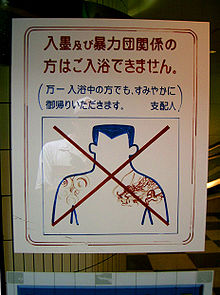- Yakuza
-
For other uses, see Yakuza (disambiguation).
Yakuza 
"Yakuza" written in katakanaPresumed origin The Kabuki-mono Creation 17th century Actual number 102,400 members[1] Principal clans Activities Criminal activities and/or legitimate businesses Yakuza (ヤクザ or やくざ ), also known as gokudō (極道), are members of traditional organized crime syndicates in Japan. The Japanese police, and media by request of the police, call them bōryokudan (暴力団), literally "violence group", while the yakuza call themselves "ninkyō dantai" (任侠団体 or 仁侠団体), "chivalrous organizations". The yakuza are notoriously known for their strict codes of conduct and very organized nature. They are very prevalent in the Japanese media and operate internationally with an estimated 80,900 members.[2]
Contents
Divisions of origin
Despite uncertainty about the single origin of yakuza organizations, most modern yakuza derive from two classifications which emerged in the mid-Edo Period: tekiya, those who primarily peddled illicit, stolen or shoddy goods; and bakuto, those who were involved in or participated in gambling.[3]
Tekiya (peddlers) were considered one of the lowest social groups in Edo. As they began to form organizations of their own, they took over some administrative duties relating to commerce, such as stall allocation and protection of their commercial activities. During Shinto festivals, these peddlers opened stalls and some members were hired to act as security. Each peddler paid rent in exchange for a stall assignment and protection during the fair.
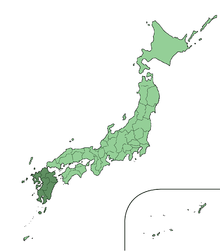 Thoroughout history, especially since the modern era, the Kyushu island has been the largest source of the yakuza members, including many renowned bosses in the Yamaguchi-gumi. Isokichi Yoshida (1867–1936) was from the Kitakyushu area and considered the first renowned modern yakuza. Recently Shinobu Tsukasa and Kunio Inoue, the bosses of the two most powerful clans in the Yamaguchi-gumi, are from Kyushu. Fukuoka, the northernmost part of the island, has the largest number of designated syndicates among all of the prefectures.
Thoroughout history, especially since the modern era, the Kyushu island has been the largest source of the yakuza members, including many renowned bosses in the Yamaguchi-gumi. Isokichi Yoshida (1867–1936) was from the Kitakyushu area and considered the first renowned modern yakuza. Recently Shinobu Tsukasa and Kunio Inoue, the bosses of the two most powerful clans in the Yamaguchi-gumi, are from Kyushu. Fukuoka, the northernmost part of the island, has the largest number of designated syndicates among all of the prefectures.
The Edo government eventually formally recognized such tekiya organizations and granted the oyabun (leaders) of tekiya a surname as well as permission to carry a sword — the wakizashi, or short samurai sword (the right to carry the katana, or full-sized samurai swords, remained the exclusive right of the nobility and samurai castes). This was a major step forward for the traders, as formerly only samurai and noblemen were allowed to carry swords.
Bakuto (gamblers) had a much lower social standing even than traders, as gambling was illegal. Many small gambling houses cropped up in abandoned temples or shrines at the edge of towns and villages all over Japan. Most of these gambling houses ran loan sharking businesses for clients, and they usually maintained their own security personnel.
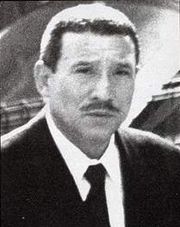 Shinobu Tsukasa, known as the current head of the Yamaguchi, the largest yakuza syndicate since the mid 20th century.
Shinobu Tsukasa, known as the current head of the Yamaguchi, the largest yakuza syndicate since the mid 20th century.
The places themselves, as well as the bakuto, were regarded with disdain by society at large, and much of the undesirable image of the yakuza originates from bakuto; this includes the name yakuza itself (ya-ku-za, or 8-9-3, is a losing hand in Oicho-Kabu, a form of blackjack).
Because of the economic situation during the mid-period and the predominance of the merchant class, developing yakuza groups were composed of misfits and delinquents that had joined or formed yakuza groups to extort customers in local markets by selling fake or shoddy goods.[3]
The roots of the yakuza can still be seen today in initiation ceremonies, which incorporate tekiya or bakuto rituals. Although the modern yakuza has diversified, some gangs still identify with one group or the other; for example, a gang whose primary source of income is illegal gambling may refer to themselves as bakuto.
Organization and activities
Structure
During the formation of the yakuza, they adopted the traditional Japanese hierarchical structure of oyabun-kobun where kobun (子分; lit. foster child) owe their allegiance to the oyabun (親分; lit. foster parent). In a much later period, the code of jingi (仁義, justice and duty) was developed where loyalty and respect are a way of life.
The oyabun-kobun relationship is formalized by ceremonial sharing of sake from a single cup. This ritual is not exclusive to the yakuza—it is also commonly performed in traditional Japanese Shinto weddings, and may have been a part of sworn brotherhood[4] relationships.
During the World War II period in Japan, the more traditional tekiya/bakuto form of organization declined as the entire population was mobilised to participate in the war effort and society came under strict military government. However, after the war, the yakuza adapted again.
Prospective yakuza come from all walks of life. The most romantic tales tell how yakuza accept sons who have been abandoned or exiled by their parents. Many yakuza start out in junior high school or high school as common street thugs or members of bōsōzoku gangs. Perhaps because of its lower socio-economic status, numerous yakuza members come from Burakumin and ethnic Korean backgrounds.
Yakuza groups are headed by an oyabun or kumichō (組長, family head) who gives orders to his subordinates, the kobun. In this respect, the organization is a variation of the traditional Japanese senpai-kōhai (senior-junior) model. Members of yakuza gangs cut their family ties and transfer their loyalty to the gang boss. They refer to each other as family members - fathers and elder and younger brothers. The yakuza is populated almost entirely by men, and there are very few women involved who are called "nee-san" (姐さん older sister). When the 3rd Yamaguchi-gumi boss (Kazuo Taoka) died in the early 1980s, his wife (Fumiko) took over as boss of Yamaguchi-gumi, albeit for a short time.
The yakuza have a very complex organizational structure. There is an overall boss of the syndicate, the kumicho, and directly beneath him are the saiko komon (senior advisor) and so-honbucho (headquarters chief). The second in the chain of command is the wakagashira, who governs several gangs in a region with the help of a fuku-honbucho who is himself responsible for several gangs. The regional gangs themselves are governed by their local boss, the shateigashira.[5]
Each member's connection is ranked by the hierarchy of sakazuki (sake sharing). Kumicho are at the top, and control various saikō-komon (最高顧問, senior advisors). The saikō-komon control their own turfs in different areas or cities. They have their own underlings, including other underbosses, advisors, accountants and enforcers.
Those who have received sake from oyabun are part of the immediate family and ranked in terms of elder or younger brothers. However, each kobun, in turn, can offer sakazuki as oyabun to his underling to form an affiliated organisation, which might in turn form lower ranked organizations. In the Yamaguchi-gumi, which controls some 2,500 businesses and 500 yakuza groups, there are even 5th rank subsidiary organizations.
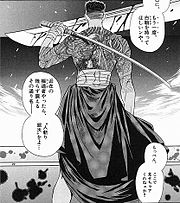 A fictional yakuza character with typical upper-body yakuza tattoos, from the Black Lagoon manga series. The yakuza is a popular subject in popular culture, such as film, television and manga.
A fictional yakuza character with typical upper-body yakuza tattoos, from the Black Lagoon manga series. The yakuza is a popular subject in popular culture, such as film, television and manga.
Rituals
Yubitsume, or the cutting of one's finger, is a form of penance or apology. Upon a first offence, the transgressor must cut off the tip of his left little finger and hand the severed portion to his boss. Sometimes an underboss may do this in penance to the oyabun if he wants to spare a member of his own gang from further retaliation.
Its origin stems from the traditional way of holding a Japanese sword. The bottom three fingers of each hand are used to grip the sword tightly, with the thumb and index fingers slightly loose. The removal of digits starting with the little finger moving up the hand to the index finger progressively weakens a person's sword grip.
The idea is that a person with a weak sword grip then has to rely more on the group for protection—reducing individual action. In recent years, prosthetic fingertips have been developed to disguise this distinctive appearance.[4]
Many yakuza have full-body tattoos. These tattoos, known as irezumi in Japan, are still often "hand-poked", that is, the ink is inserted beneath the skin using non-electrical, hand-made and hand held tools with needles of sharpened bamboo or steel. The procedure is expensive and painful and can take years to complete.[6]
When yakuza members play Oicho-Kabu cards with each other, they often remove their shirts or open them up and drape them around their waists. This allows them to display their full-body tattoos to each other. This is one of the few times that yakuza members display their tattoos to others, as they normally keep them concealed in public with long-sleeved and high-necked shirts. When new members join, they are often required to remove their trousers as well and reveal any lower body tattoos.[citation needed]
Syndicates
The three largest syndicates
Although yakuza membership has declined following an antigang law aimed specifically at yakuza and passed by the Japanese government in 1992, there are thought to be more than 103,000 active yakuza members in Japan today. Although there are many different yakuza groups, together they form the largest organized crime group in the world.[7]
Principal families Description Mon (crest) Yamaguchi-gumi
(六代目山口組 Rokudaime Yamaguchi-gumi)Created in 1915, the Yamaguchi-gumi is the biggest yakuza family, accounting for 50% of all yakuza in Japan, with more than 55,000 members divided into 850 clans. Despite more than one decade of police repression, the Yamaguchi-gumi has continued to grow. From its headquarters in Kobe, it directs criminal activities throughout Japan. It is also involved in operations in Asia and the United States. Shinobu Tsukasa, also known as Kenichi Shinoda, is the Yamaguchi-gumi's current oyabun. He follows an expansionist policy, and has increased operations in Tokyo (which has not traditionally been the territory of the Yamaguchi-gumi.) The Yamaguchi family is successful to the point where its name has become synonymous with Japanese organized crime in many parts of Asia outside of Japan. Many Chinese or Korean persons who do not know the name "Yakuza" would know the name "Yamaguchi-gumi", which is frequently portrayed in gangster movies.

"The meaning of the samurai sword is in the warrior and the sword as one it could be a dangerous opponent" Yamabishi (山菱)
Sumiyoshi-kai
(住吉会)The Sumiyoshi-rengo is the second largest yakuza family, with 20,000 members divided into 277 clans. The Sumiyoshi-kai, as it is sometimes called, is a confederation of smaller yakuza groups. Its current oyabun is Shigeo Nishiguchi. Structurally, Sumiyoshi-kai differs from its principal rival, the Yamaguchi-gumi, in that it functions like a federation. The chain of command is more lax, and although Shigeo Nishiguchi is always the supreme oyabun, its leadership is distributed among several other people. 
Inagawa-kai
(稲川会)The Inagawa-kaï is the third largest yakuza family in Japan, with roughly 15,000 members divided into 313 clans. It is based in the Tokyo-Yokohama area and was one of the first yakuza families to expand its operations to outside of Japan. Its current oyabun is Hideki Inagawa. 
Designated boryokudan
A designated boryokudan (指定暴力団 Shitei Bōryokudan)[8] is a "particularly harmful" yakuza group[9] registered by the Prefectural Public Safety Commissions under the Organized Crime Countermeasures Law (暴力団対策法 Bōryokudan Taisaku Hō) enacted in 1991.[10]
Under the Organized Crime Countermeasures Law, the Prefectural Public Safety Commissions have registered 22 syndicates as the designated boryokudan groups.[11] Fukuoka Prefecture has the largest number of designated boryokudan groups among all of the prefectures, at 5; the Kudo-kai, the Taishu-kai, the Fukuhaku-kai, the Dojin-kai and the Kyushu Seido-kai.[12]
Designated boryokudan groups are usually large, old-established organizations (mostly formed before the World War II, some even formed before the Meiji Revolution of the 19th century), however there are some exceptions such as the Kyushu Seido-kai which, with its blatant armed conflicts with the Dojin-kai, was registered only two years after its formation.
The numbers which follow the names of boryokudan groups refer to the group's leadership. For example, Yoshinori Watanabe headed the Yamaguchi-gumi fifth; on his retirement, Shinobu Tsukasa became head of the Yamaguchi-gumi sixth, and "Yamaguchi-gumi VI" is the group's formal name.
Name Headquarters Reg. in Name Headquarters Reg. in  Yamaguchi-gumi VI
Yamaguchi-gumi VIHyogo 1992  Dojin-kai
Dojin-kaiFukuoka 1992  Inagawa-kai
Inagawa-kaiTokyo 1992  Shinwa-kai II
Shinwa-kai IIKagawa 1992  Sumiyoshi-kai
Sumiyoshi-kaiTokyo 1992  Soai-kai
Soai-kaiChiba 1992  Kudo-kai IV
Kudo-kai IVFukuoka 1992  Kyodo-kai III
Kyodo-kai IIIHiroshima 1993  Kyokuryu-kai IV
Kyokuryu-kai IVOkinawa 1992  Taishu-kai
Taishu-kaiFukuoka 1993  Okinawa Kyokuryu-kai
Okinawa Kyokuryu-kaiOkinawa 1992  Sakaume-gumi VIII
Sakaume-gumi VIIIOsaka 1993  Aizukotetsu-kai VI
Aizukotetsu-kai VIKyoto 1992  Kyokuto-kai
Kyokuto-kaiTokyo 1993  Kyosei-kai V
Kyosei-kai VHiroshima 1992  Azuma-gumi II
Azuma-gumi IIOsaka 1993  Goda-ikka VII
Goda-ikka VIIYamaguchi 1992  Matsuba-kai
Matsuba-kaiTokyo 1994  Kozakura-ikka IV
Kozakura-ikka IVKagoshima 1992  Fukuhaku-kai III
Fukuhaku-kai IIIFukuoka 2000  Asano-gumi IV
Asano-gumi IVOkayama 1992  Kyushu Seido-kai
Kyushu Seido-kaiFukuoka 2008 Other notable bōryokudan
Name Japanese name Headquarters Leader Tōkyō-Morishiro-Hoshi-ikka-Ōta III 東京盛代星一家太田三代目 Iwate Seigo Ōta Genseida-Kōyū-kai 源清田交友会 Ibaraki Shiroo Tanabe Yorii-bunke V 寄居分家五代目 Gunma Hiroshi Godai Kameya-ikka V 五代目亀屋一家 Saitama Akira Shirahata Yoshiha-kai VII 七代目吉羽会 Saitama Kiyomasa Nakamura Takezawa-kai 竹澤会 Chiba Haruo Ōtawa Anegasaki-kai 姉ヶ崎会 Tōkyō Shigetami Nakanome Iijima-kai VIII 八代目飯島会 Tōkyō Kanji Nishikawa Okaniwa-kai 岡庭会 Tōkyō Seiichiro Okaniwa Kanda-Takagi VII 神田高木七代目 Tōkyō Akira Nagamura Shitaya-Hanajima-kai VII 下谷花島会七代目 Tōkyō Isamu Ōsaka Jōshūya-kai 上州家会 Tōkyō Katsuhiko Itō Shinmon-rengōkai 新門連合会 Tōkyō Naoaki Kasama Sugitō-kai 杉東会 Tōkyō Tomoaki Nohara Daigo-kai 醍醐会 Tōkyō Hideo Aoyama Chōjiya-kai 丁字家会 Tōkyō Goro Yoshida Tōa-kai 東亜会 Tōkyō Yoshio Kaneumi Hashiya-kai 箸家会 Tōkyō Hiroshi Minemura Hanamata-kai 花又会 Tōkyō Akira Kiyono Masuya-kai 桝屋会 Tōkyō Sotojiro Higashiura Matsuzakaya-ikka V 五代目松坂屋一家 Tōkyō Takiti Nishimura Ametoku-rengōkai 飴德連合会 Kanagawa Hideya Nagamochi Yokohama-Kaneko-kai 横浜金子会 Kanagawa Takashi Terada Sakurai-sōke 櫻井總家 Shizuoka Hiroyoshi Sano Chūkyō-Shinnō-kai 中京神農会 Aichi Eizō Yamagashira Marutomi-rengōkai 丸富連合会 Kyōto Hitoshi Kitabashi Chūsei-kai 忠成会 Hyōgo Masaaki Ōmori Matsuura-gumi II 二代目松浦組 Hyōgo Kazuo Kasaoka Takenaka-gumi II 二代目竹中組 Okayama Masashi Takenaka Chūgoku-Takagi-kai II 二代目中国高木会 Hiroshima Akio Kitayama Kumamoto-kai II 二代目熊本會 Kumamoto Yutaka Tozaki Sanshin-kai 山心会 Kumamoto Atsushi Inoue Murakami-gumi III 九州三代目村上組 Ōita Hajime Murakami Current activities
Japan
Much of the current activities of the yakuza can be understood in the light of their feudal origin. First, they are not a secret society like their counterparts of the Italian mafia and Chinese triads. Yakuza organizations often have an office with a wooden board on the front door, openly displaying their group name or emblem.[citation needed]
"...The yakuza tend to be gentler than their Italian cousins. In general, they are not involved in theft, burglary, armed robbery, or other street crimes." — Jake Adelstein[13]
Members often wear sunglasses and colourful suits so that their profession can be immediately recognized by civilians (katagi). Even the way many yakuza walk is different from ordinary citizens. Their wide gait is markedly different from the unassuming way many Japanese prefer to adopt.[citation needed] Alternatively, yakuza can dress more conservatively and flash their tattoos to indicate their affiliation when the need arises. On occasion, they also sport insignia pins on their lapels. One yakuza family[which?] even printed a monthly newsletter with details on prisons, weddings, funerals, murders, and poems by leaders.[citation needed]
Until recently, the majority of yakuza income came from protection rackets in shopping, entertainment and red-light districts within their territory. This is mainly due to the reluctance of such businesses to seek help from the police. The Japanese police are also reluctant to interfere in internal matters in recognized communities such as shopping arcades, schools/universities, night districts and so on.[citation needed]
In this sense, yakuza are still regarded as semi-legitimate organizations. For example, immediately after the Kobe earthquake, the Yamaguchi-gumi, whose headquarters are in Kobe, mobilized itself to provide disaster relief services (including the use of a helicopter), and this was widely reported by the media as a contrast to the much slower response by the Japanese government.[14][15] The yakuza repeated their aid after the 2011 Tōhoku earthquake and tsunami, with groups opening their offices to refugees and sending dozens of trucks with supplies to affected areas.[16] For this reason, many yakuza regard their income and hustle (shinogi) as a collection of a feudal tax.
Yakuza are heavily involved in sex-related industries, such as smuggling uncensored pornography from Europe, Australia and America into Japan (as the local pornography is censored in ways Western pornography is not). They also control large prostitution rings throughout the country.
The Philippines is another source of young women. Yakuza trick girls from impoverished villages into coming to Japan, where they are promised respectable jobs with good wages. Instead, they are forced into becoming prostitutes and strippers.[17]
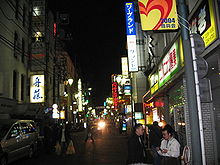 The alleys and streets of Shinjuku are a popular modern Tokyo yakuza hangout.
The alleys and streets of Shinjuku are a popular modern Tokyo yakuza hangout.
Yakuza frequently engage in a uniquely Japanese form of extortion, known as sōkaiya. In essence, this is a specialized form of protection racket. Instead of harassing small businesses, the yakuza harasses a stockholders' meeting of a larger corporation. They simply scare the ordinary stockholder with the presence of yakuza operatives, who obtain the right to attend the meeting by a small purchase of stock.
They also engage in simple blackmail, obtaining incriminating or embarrassing information about a company's practices or leaders. Once the yakuza gain a foothold in these companies, they will work for them to protect the company from having such internal scandals exposed to the public. Some companies still include payoffs as part of their annual budget.[citation needed]
The yakuza have a strong influence in Japanese professional wrestling, or puroresu. Most of their interest in wrestling activities and promotions is purely financial. The yakuza have mostly gotten involved by financially supporting wrestling promotions with fading fortunes, or simple business loans. Many venues used by wrestling are connected to the yakuza, and as such, when a promotion uses one of their sites, the yakuza receive a percentage of the gate.[citation needed] The yakuza as a whole is regarded as a great supporter of both puroresu and MMA. It's not unusual for wrestlers to receive specific instructions on what to do in their matches so as to appeal just to yakuza members in the crowd. It is thought in Japan that it is safe to say that none of the large wrestling promotions in Japan would fold, because they would be rescued by the yakuza.
The pioneer of wrestling in Japan, Rikidōzan, was killed by the yakuza.[citation needed] Former WWE wrestler Yoshihiro Tajiri was asked to start a yakuza gimmick, an offer he quickly refused, fearing that he would be targeted by the real yakuza. Professional wrestler Yoshiaki Fujiwara is often referred to as Kumicho (i.e., "Godfather") and his wrestling promotion was called the Pro Wrestling Fujiwara Gumi. He often portrays yakuza figures as an actor on Japanese television.
Yakuza also have ties to the Japanese realty market and banking, through jiageya. Jiageya specialize in inducing holders of small real estate to sell their property so that estate companies can carry out much larger development plans. Japan's bubble economy of the 1980s is often blamed on real estate speculation by banking subsidiaries. After the collapse of the Japanese property bubble, a manager of a major bank in Nagoya was assassinated, and much speculation ensued about the banking industry's indirect connection to the Japanese underworld.
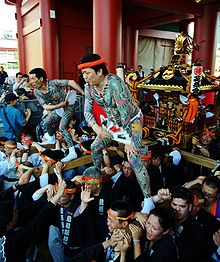 Yakuza often take part in local festivals such as Sanja Matsuri where they often carry the shrine through the streets proudly showing off their elaborate tattoos.
Yakuza often take part in local festivals such as Sanja Matsuri where they often carry the shrine through the streets proudly showing off their elaborate tattoos.
Yakuza have been known to make large investments in legitimate, mainstream companies. In 1989, Susumu Ishii, the Oyabun of the Inagawa-kai (a well known yakuza group) bought US$ 255 million worth of Tokyo Kyuko Electric Railway's stock.[18] Japan's Securities and Exchange Surveillance Commission has knowledge of more than 50 listed companies with ties to organized crime, and in March 2008, the Osaka Securities Exchange decided to review all listed companies and expel those with yakuza ties.[19]
As a matter of principle, theft is not recognised as a legitimate activity of yakuza. This is in line with the idea that their activities are semi-open; theft by definition would be a covert activity. More importantly, such an act would be considered a trespass by the community. Also, yakuza usually do not conduct the actual business operation by themselves. Core business activities such as merchandising, loan sharking or management of gambling houses are typically managed by non-yakuza members who pay protection fees for their activities.
There is much evidence of yakuza involvement in international crime. There are many tattooed yakuza members imprisoned in various Asian prisons for such crimes as drug trafficking and arms smuggling. In 1997, one verified yakuza member was caught smuggling 4 kilograms (8.82 pounds) of heroin into Canada.
In 1999, Italian-American mafia Bonanno family member, Mickey Zaffarano, was overheard talking about the profits of the pornography trade that both families could profit from.[20] Another yakuza racket is bringing women of other ethnicities/races, especially East European[20] and Asian[20] to Japan under the lure of a glamorous position, then forcing the women into prostitution.[citation needed]
Because of their history as a legitimate feudal organization and their connection to the Japanese political system through the uyoku (extreme right-wing political groups), yakuza are somewhat a part of the Japanese establishment, with six fan magazines reporting on their activities. One study found that one in ten adults under the age of 40 believed that the yakuza should be allowed to exist[16]. In the 1980s in Fukuoka, a yakuza war spiraled out of control and civilians were hurt. It was a large conflict between the Yamaguchi-gumi and Dojin-kai, called the Yama-Michi War. The police stepped in and forced the yakuza bosses on both sides to declare a truce in public.
At various times, people in Japanese cities have launched anti-yakuza campaigns with mixed and varied success. In March 1995, the Japanese government passed the Act for Prevention of Unlawful Activities by Criminal Gang Members which made traditional racketeering much more difficult. Beginning in 2009, led by agency chief Takaharu Ando, Japanese police began to crack down on the gangs. Kodo-kai chief Kiyoshi Takayama was arrested in late 2010. In December 2010, police arrested Yamaguchi-gumi's alleged number three leader, Tadashi Irie. According to the media, encouraged by tougher anti-yakuza laws and legislation, local governments and construction companies have begun to shun or ban yakuza activities or involvement in their communities or construction projects.[21] The police are handicapped, however, by Japan's lack of an equivalent to plea bargaining, witness protection, or the United States' RICO Act.[19] Laws were enacted in Osaka and Tokyo in 2010 and 2011 to try to combat Yakuza influence by making it illegal for any business to do business with the Yakuza.[22]
Ironically, Kobe, the home city of the largest yakuza syndicate Yamaguchi-gumi, is one of the safest cities in Japan, because "cheap" criminals such as street gangs and thugs are afraid to attract the yakuza's attention so they avoid being active in the city.
United States
Yakuza activity in the United States is mostly relegated to Hawaii, but they have made their presence known in other parts of the country, including Los Angeles, San Francisco, Seattle, Las Vegas, Arizona, Virginia, Chicago, and New York City.[23][24] The yakuza are said to use Hawaii as a way station between Japan and mainland America, smuggling crystal methamphetamine into the country and smuggling back firearms to Japan. They easily fit into the local population, since many tourists from Japan and other Asian countries visit the islands on a regular basis, and many Hawaii residents are of full or partial Japanese descent. They also work with local gangs, funneling Japanese tourists to gambling parlors and brothels.[23]
In California, the yakuza have made alliances with local Vietnamese and Korean gangs as well as Chinese triads. In New York City, they appear to collect finders fees from American mafiosos and businessmen for guiding Japanese tourists to gambling establishments, both legal and illegal.[23]
Handguns manufactured in the U.S. account for a large share (33%) of handguns seized in Japan, followed by China (16%), and the Philippines (10%). In 1990, a Smith & Wesson .38 caliber revolver that cost $275 in the U.S. could sell for up to $4,000 in Tokyo. By 1997 it would sell for only $500, due to the proliferation of guns in Japan during the 1990s.[24]
The FBI suspects that the yakuza use various operations to launder money in the U.S.[19]
In 2001, the FBI's representative in Tokyo arranged for Tadamasa Goto, the head of the group Goto-gumi, to receive a liver transplant in the United States, in return for information of Yamaguchi-gumi operations in the U.S. This was done without prior consultation of the NPA. The journalist who uncovered the deal received threats by Goto and was given police protection in the US and in Japan.[19]
Mexico
Yakuza in Mexico are most notably involved in illegal immigration. There were cases in the 1990s of yakuza recruiting young women (mainly with diplomas and good English knowledge) with promises of legitimate work in Japan.[citation needed] When the women arrived in Japan they were forced into prostitution. Some women were able to escape their employers and return home to Mexico and alert authorities. In some incidents, Mexican authorities were able to apprehend the yakuza members and deported them as illegal immigrants.
Similar incidents have also occurred in Peru where women have been enticed to work in Japan. The Association of Hispanic Women Against Discrimination and Gender Violence or "Women in Action" estimates nearly 3,000 Mexican women recruited by the various yakuza clans prostitute themselves in Japan.[citation needed]
North Korea
Yakuza member Yoshiaki Sawada was released in North Korea after spending 5 years within the country for bribing a North Korean official and drug-smuggling.[25]
Constituent member
According to a 2006 speech by Mitsuhiro Suganuma, a former officer of the Public Security Intelligence Agency, around 60 percent of yakuza members come from burakumin, the descendants of a feudal outcast class and approximately 30 percent of them are Japanese-born Koreans, and only 10 per cent are from non-burakumin Japanese and Chinese ethnic groups.[26][27] Foreign ethnicities in the modern yakuza include Okinawan (officially classified as Japanese), Korean, Taiwanese, and to a lesser extent, Southeast Asian (mostly Filipino), South American (mostly Brazilian), Turkish, Chinese, Eastern European, Iranian, Nigerian, among others[citation needed].
Burakumin
The Burakumin are a group that is socially discriminated against in Japanese society, whose recorded history goes back to the Heian Period in the 11th century. The burakumin are descendants of outcast communities of the pre-modern, especially the feudal era, mainly those with occupations considered tainted with death or ritual impurity, such as butchers, executioners, undertakers or leather workers. They traditionally lived in their own secluded hamlets.
According to David E. Kaplan and Alec Dubro, burakumin account for about 70% of the members of Yamaguchi-gumi, the largest yakuza syndicate in Japan.[28]
Mitsuhiro Suganuma, ex-officer of the Public Security Intelligence Agency, testified that burakumin account for about 60% of the members of the entire yakuza.[29]
Ethnic Koreans
While Koreans in Japan make up only 0.5% of the population, they are a prominent part of yakuza, despite or perhaps because Koreans suffer severe discrimination in Japanese society along with burakumin.[30][31] In the early 1990s, 18 of 90 top bosses of Inagawa-kai were ethnic Koreans. National Police Agency (Japan) suggested Koreans composed 10% along with 70% of burakumin in Yamaguchi-gumi.[30] Some of the representatives of the designated Bōryokudan are also.[32] The Korean significance had been an untouchable taboo in Japan and one of the reasons that the Japanese version of Kaplan and Dubro's Yakuza (1986) had not been published until 1991 with deletion of Korean-related description such as the component of Yamaguchi-gumi.[33]
Although Japanese-born people of Korean ancestry are a significant segment of the Japanese population, they are still considered resident aliens because of their nationality. But Koreans, who are often shunned in legitimate trades, are embraced by the Japanese yakuza precisely because they fit the group's "outsider" image.[34]
Prominent individuals of Korean descent in the world of the yakuza have included Hisayuki Machii, the founder of the Tosei-kai, Tokutaro Takayama, the president of the 4th Aizukotetsu-kai, Jiro Kiyota, the president of the 5th Inagawa-kai, Hirofumi Hashimoto, the head of the Kyokushinrengo-kai (a Yamaguchi-gumi clan). Oddly, prominent individuals of Korean (and many other foreign) origin in the world of yakuza tend to be known for their intense Japanese nationalism, which is not an inherent tendency of the yakuza itself, often founding their own uyoku (right-wing) organizations.
See also
- Bōsōzoku
- Criminal tattoo
- List of criminal enterprises, gangs and syndicates
- Mafia
- Organized crime
- Punch perm
- Russian Mafia
- Triads
Notes
- ^ "Criminal Investigation: Fight Against Organized Crime (1)". Overview of Japanese Police. National Police Agency. June 2007. http://www.npa.go.jp/english/kokusai/pdf/Poj2007-33.pdf. Retrieved 2008-06-23.
- ^ Corkill, Edan, "Ex-Tokyo cop speaks out on a life fighting gangs — and what you can do", Japan Times, 6 November 2011, p. 7.
- ^ a b Kaplan, David; Dubro, Alec (2004), pp. 18–21.
- ^ a b http://www.trutv.com/library/crime/gangsters_outlaws/gang/yakuza/2.html
- ^ The Yakuza, the Japanese Mafia - The Crime Library - Crime Library on truTV.com
- ^ Japanorama, BBC Three, Series 2, Episode 3, first aired 21 September 2006
- ^ Johnston, Eric, "From rackets to real estate, yakuza multifaceted", Japan Times, 14 February 2007, p. 3.
- ^ "Police of Japan 2011, Criminal Investigation : 2. Fight Against Organized Crime", December 2009, National Police Agency
- ^ "The Organized Crime Countermeasures Law", The Fukuoka Prefectural Center for the Elimination of Boryokudan (Japanese)
- ^ "Boryokudan Comprehensive Measures — The Condition of the Boryokudan", December 2010, Hokkaido Prefectural Police (Japanese)
- ^ "List of Designated Bōryokudan", February 24, 2011, Nagasaki Prefectural Police (Japanese)
- ^ "Retrospection and Outlook of Crime Measure", p.15, Masahiro Tamura, 2009, National Police Agency (Japanese)
- ^ "The Last Yakuza", 3 August 2010, World Policy Institute
- ^ Quake in Japan: Gangsters; Gang in Kobe Organizes Aid for People In Quake, The New York Times, http://query.nytimes.com/gst/fullpage.html?res=990CE2DF1E31F931A15752C0A963958260.
- ^ Yasuyuki Sawada, Satoshi Simizutani (2008) How Do People Cope with Natural Disasters? Evidence from the Great Hanshin-Awaji (Kobe) Earthquake in 1995. Journal of Money, Credit and Banking 40:2–3, 463-88.
- ^ a b Adelstein, Jake (2011-03-18). "Yakuza to the Resecue". The Daily Beast. http://www.thedailybeast.com/blogs-and-stories/2011-03-18/japanese-yakuza-aid-earthquake-relief-efforts/full/. Retrieved 2011-03-18.
- ^ The Yakuza, the Japanese Mafia - The Crime Library - Crime Library on truTV.com
- ^ Dubro, Alec; Kaplan, David E, Yakuza: Japan's Criminal Underworld, Questia, http://www.questia.com/library/book/yakuza-japans-criminal-underworld-by-alec-dubro-david-e-kaplan.jsp.
- ^ a b c d Jake Adelstein. This Mob Is Big in Japan, The Washington Post, 11 May 2008
- ^ a b c Kaplan and Dubro; Yakuza: Expanded Edition (2003, University of California Press, ISBN 0-520-21562-1)
- ^ Zeller, Frank (AFP-Jiji), "Yakuza served notice days of looking the other way are over," Japan Times, 26 January 2011, p. 3.
- ^ Botting, Geoff, "Average Joe could be collateral damage in war against yakuza", Japan Times, 16 October 2011, p. 9.
- ^ a b c Yakuza, Crimelibrary.com
- ^ a b Yakuza: Japan's Criminal Underworld (2003) Kaplan, D. & Dubro, A Part IV
- ^ Yakuza returns after five years in North Korea jail on drug charge 2009-01-16 The Japan Times
- ^ "Mitsuhiro Suganuma, "Japan's Intelligence Services"". The Foreign Correspondents' Club of Japan. http://www.fccj.or.jp/node/1468.
- ^ "Capital punishment - Japan's yakuza vie for control of Tokyo". Jane’s Intelligence Review: 4. December 2009. http://www.janes.com/products/janes/defence-security-report.aspx?ID=1065926328&channel=security. "Around 60 per cent of yakuza members come from burakumin, the descendants of a feudal outcast class, according to a 2006 speech by Mitsuhiro Suganuma, a former officer of the Public Security Intelligence Agency. He also said that approximately 30 per cent of them are Japanese-born Koreans, and only 10 per cent are from non-burakumin Japanese and Chinese ethnic groups." Archived by the author
- ^ Dubro, Alec and David Kaplan, Yakuza: The Explosive Account of Japan's Criminal Underworld (Reading, Massachusetts: Addison-Wesley Publishing Co., 1986).
- ^ [1]
- ^ a b Yakuza: Japan's Criminal Underworld (2003) Kaplan, D. & Dubro, A. p. 133.
- ^ KRISTOF, NICHOLAS (1995-11-30). "Japan's Invisible Minority: Better Off Than in Past, but StillOutcasts". The New York Times. http://query.nytimes.com/gst/fullpage.html?res=9B01E7DB1139F933A05752C1A963958260&sec=&spon=&pagewanted=3. Retrieved 2008-01-17.
- ^ (Japanese) "Boryokudan Situation in the Early 2007", National Police Agency, 2007, p. 22. See also Bōryokudan#Designated bōryokudan.
- ^ Kaplan and Dubro (2003) Preface to the new edition.
- ^ Bruno, A. (2007). "The Yakuza, the Japanese Mafia" CrimeLibrary: Time Warner
References
- Bruno, A. (2007). "The Yakuza, the Japanese Mafia" CrimeLibrary: Time Warner
- Kaplan, David, Dubro Alec. (1986). Yakuza Addison-Wesley (ISBN 0-201-11151-9)
- Kaplan, David, Dubro Alec. (2003). Yakuza: Expanded Edition University of California Press (ISBN 0-520-21562-1)
- Hill, Peter B.E. (2003). The Japanese Mafia: Yakuza, Law, and the State Oxford University Press (ISBN 0-19-925752-3)
- Johnson, David T. (2001). The Japanese Way of Justice: Prosecuting Crime in Japan Oxford University Press (ISBN 0-19-511986-X)
- Miyazaki, Manabu. (2005) Toppamono: Outlaw. Radical. Suspect. My Life in Japan's Underworld Kotan Publishing (ISBN 0-9701716-2-5)
- Seymour, Christopher. (1996). Yakuza Diary Atlantic Monthly Press (ISBN 0-87113-604-X)
- Saga, Junichi., Bester, John. (1991) Confessions of a Yakuza: A Life in Japan's Underworld Kodansha America
- Schilling, Mark. (2003). The Yakuza Movie Book Stone Bridge Press (ISBN 1-880656-76-0)
- Sterling, Claire. (1994). Thieves' World Simon & Schuster (ISBN 0-671-74997-8)
- Sho Fumimura (Writer), Ryoichi Ikegami (Artist). (Series 1993-1997) "Sanctuary" Viz Communications Inc (Vol 1: ISBN 0-929279-97-2; Vol 2:ISBN 0-929279-99-9; Vol 3: ISBN 1-56931-042-4; Vol 4: ISBN 1-56931-039-4; Vol 5: ISBN 1-56931-112-9; Vol 6: ISBN 1-56931-199-4; Vol 7: ISBN 1-56931-184-6; Vol 8: ISBN 1-56931-207-9; Vol 9: ISBN 1-56931-235-4)
- Tendo, Shoko (2007). Yakuza Moon: Memoirs of a Gangster's Daughter Kodansha International [2] (ISBN 978-4-7700-3042-9)
- Young Yakuza. Dir. Jean-Pierre Limosin. Cinema Epoch, 2007.
- The 6th Yamaguchi-gumi Inheritance
- The 3rd Inagawa-kai Inheritance
- The 7th Sumiyoshi-kai Inheritance
- Blood ties: Yakuza daughter lifts lid on hidden hell of gangsters' families
- Crime Library: Yakuza
- Yakuza slang
- Yakuza hair style
- Japanese Mayor Shot Dead; CBS News, 17 April 2007
- Yakuza: The Japanese Mafia
- "The "Underworld" Goes Underground: Yakuza in Japanese Politics" -(Harvard Asia Quarterly)
Organized crime groups in Asia National groups Categories:- Japanese words and phrases
- Gangs in Asia
- Organized crime groups
- Organized crime groups in Asia
- Organized crime groups in Japan
- Organized crime groups in the United States
- Organized crime groups in the United States by ethnicity
- Secret societies related to organized crime
- Transnational organized crime
- Yakuza
Wikimedia Foundation. 2010.


